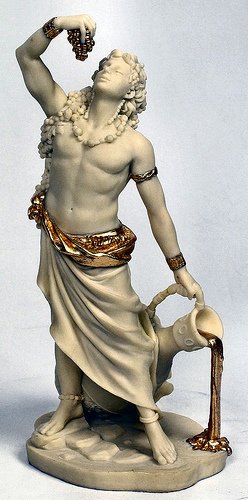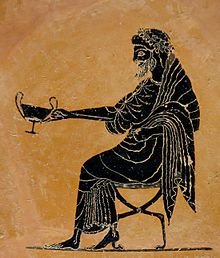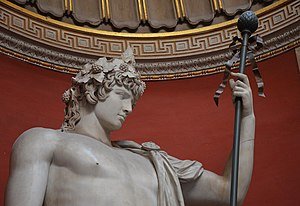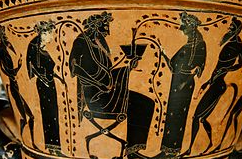Ancient Greek God Dionysus: Birth Story, Powers, Meaning & Symbols

Ancient Greek god Dionysus meaning and symbols
In the ancient Greek pantheon of gods and goddesses, Dionysus was the god people called upon when they wanted to kick up their feet and just chill. Dionysus had dominion over a number of “cool” stuffs such as wine making, pleasure, festivities, wild frenzy, vegetation, and madness. Unlike his fellow other deities, the god of wine proved to be the fun-loving type. During the Roman era, Dionysus iteration was known as Bacchus. The following explores the meaning and symbols of Dionysus:
Quick Facts about Dionysus
God of: Wine, theater, fertility, vegetation, ecstasy and pleasure
Popular Symbols: Vine, drinking cup, ivy
Parents: Zeus and Semele
Siblings: Hercules, Ares, Artemis, Apollo, Athena, etc.
Consort: Ariadne
Abode: Mount Olympus
Symbols: ivy, lions, leopards, grapes, thyrsus, Kantharos, serpent, bull, tigers
Roman iteration: Bacchus
Other names: Dionysos
Dionysus’s peculiar birth story
The charming and sweet-talking Greek God, Dionysus, was a member of the 12 Olympian deities who made Mount Olympus their home. His parents were Zeus, the allfather god in Greek mythology, and Semele, a mortal woman.
Dionysus birth story is a very interesting one because one of his parents – Semele – was a mortal woman. Normally, full-fledged Greek gods/goddesses have both parents all gods and goddesses themselves. However, that was not the case in Dionysus birth. Dionysus was born a full-fledged god from the union between Zeus and Semele.
Death of Dionysus’ mother
According ancient Greek myths, Zeus – the God king of Olympus – fell madly in love with Semele, the daughter of Cadmus, king of Thebes. After a brief period of interaction, Semele got pregnant with Dionysus. Hera (Zeus’ wife) was absolutely livid when she got news of Semele’s pregnancy. Hera, who is also Queen of Mount Olympus, transformed herself into an old woman and came down to earth to convince Semele to ask Zeus to reveal his full godly look. When Semele asked, Zeus dutifully complied with her request. Upon seeing Zeus in all his splendor and unchecked godly form, the mortal Semele burst into flames and died.
Not wanting the unborn child that Semele was carrying to die, Zeus quickly picked it up and sewed it into his thigh. And so, Dionysus was nursed in Zeus’ thigh for a period of time before he was born, for the second time. Perhaps this is why Dionysus turned out to be a full-fledged god. Had he been birthed out by Semele, Dionysus might have ended up a mere demi-god, almost like Heracles (Hercules) or Sarpedon.
In order to avoid the wrath of Hera falling heavily on baby Dionysus, Zeus put the baby in the care of nymphs and satyrs. A man called Silenus served as the counselor and teacher of Dionysus in his childhood.
Read More: 9 Most Famous Sons of Zeus in Greek Mythology
Importance and the Role of Dionysus
Dionysus’s importance lies in the fact that wine was an extremely crucial part in the lives of ancient Greeks. For example, Homer’s description of Dionysus states that the god was the “joy of men”. Simply put, wherever Dionysus went wine flowed abundantly. Owing to this, the god became absolutely beloved by the Greeks, especially men.
The myth further states that Dionysus roamed the world, blessing people with the knowledge of wine and merry making. Dionysus gifted a vine tree to nobleman Ikarios. The myth goes on to say that Dionysus showed Ikarious how to make wine form the vine.
Dionysus: Meaning, Symbols and depictions

Dionysus extending his drinking cup (kantharos). Picture: late 6th century BCE
Dionysus was typically associated with vine, ivy, lions, leopards, grapes, thyrsus (a rod) and Kantharos (a drinking cup/horn). According to the myth, Dionysus’s magical wine cup never run out of wine.
Additionally, many depictions of him portrayed him wearing a wreath of ivy with a pelt (hide) of a panther. The ancients held the belief that Dionysus often rode an ithyphallic mule or a languid. There are also sculptures and paintings of infant Dionysus in the arms of Hermes of Praxiteles.
Between 6th and 4th centuries BC, Dionysus often appeared on coins from Naxos, Mende, Crete, and Thebes. Within that period, Dionysus also appeared bearded. However, after the 5th century BC, the common depictions of Dionysus was beardless.
The Greeks also associated Dionysus with the theatre, celebratory events, ecstatic dance, fertility and even madness (more on this below).
Powers and abilities
Dionysus was a colossal, immortal god with a number of powers. He is believed to have the power to inspire people to greatness. He was also able to create wild frenzy and euphoria among mortals. In many cases, mortals that crossed Dionysus often went insane.
Because he was the god of wine, Dionysus could make vines grow extremely fast. Like other Olympians, Dionysus had god-like strengths and wits. He also had the power to transform into certain animals, including a lion and a bull.
The Thyrsus of Dionysus
Thyrsus is considered Dionysus most preferred weapon of choice. The thyrsus, which is described as an ivy vine-covered staff, could be used by Dionysus to turn water into wine. He also used thyrsus to induce his followers into an ecstatic frenzy or madness. Make no mistake, Dionysus thyrsus carried a lot of punch in it, as it could be used in a lethal manner during battles.

Antinous holding the thyrsus while posed as Dionysus (Museo Pio-Clementino). Antinous, a close friend of Emperor, was deified in ancient Rome on the orders of Hadrian.
Dionysus and King Midas
Dionysus was the Greek god that bestowed upon King Midas the unique ability to turn whatever he touched into gold. When Midas realized how awful his power was, he begged Dionysus to restore him to his old self. After a bath in the Pactolus River, Midas lost his touch and became normal.
Hera versus Dionysus
Still furious about Zeus’ infidelity and the birth of Dionysus, Hera sent a band of Titans to rough Dionysus up and tear him apart, limb for limb. Hera was a very jealous goddess. Rhea, Zeus’ mother, found some parts of Dionysus and brought him back to life. After that, Rhea handed Dionysus to the mountain nymphs for safe keeping.
More:
- Myths and Early Portrayals of Hermes, the Greek God of Messengers
- The Origin Story and Powers of Greek Titan, Atlas
Dionysus and the Pirates
Unaware that Dionysus was a god, a group of pirates took Dionysus hostage. They hoped to demand ransom from his family. Dionysus transformed into a lion and caused the pirates to jump into the sea. Once in the sea, Dionysus turned every one of the pirate into a dolphin. The god did however take pity on one of the pirates by letting him live.
Dionysus and Ariadne
After Theseus – the Greek hero who killed the Minotaur – abandoned Princess Ariadne, the daughter of King Minos of Crete, on the island of Naxos, Dionysus swooped in and courted Ariadne. The duo fell in love and got married. Dionysus is famed for being the only Greek god who remained faithful to his wife.
More:
- Aphrodite in Ancient Greek Mythology
- Myths and Facts about Poseidon, the Greek God of the Sea
- Everything that you need to know about the Minotaur in Greek Mythology
Theatre of Dionysus

Dionysus meaning and symbols | Image: Theater of Dionysus – Acropolis, Athens
The Theatre of Dionysus is regarded by many scholars as the oldest known theatre of ancient Greece. It was unearthed by a team of archeologists led by German archeologist Wilhelm Dorpfeld in the 19th century AD. The Theatre of Dionysus, which lies on the southern slope of the Acropolis in Athens, could hold more than 15,000 people. It’s also been stated that famous Greek tragedians – such as Sophocles, Aeschylus and Euripides – possibly staged some of their plays in this theatre.
Worship of Dionysus
In one account of the myths, Hera caused Dionysus to go mad. This made him roam the world from place to place aimlessly. While on his journey around the world, Dionysus impacted the craft of wine making to humans. Wherever he went, he taught people how to make the best type of wine from grapes. As a result, the cult of Dionysus flourished in those places.
During some rituals, the ancient Greeks honored Dionysus by consuming excessive amounts of wine. They also danced and partied for days. It is believed that, the spirit of Dionysus resided in all those that took part in the merry making. Owing to the alcohol content in the wine, the drinker lost control of him/herself, thereby paving way for the god Dionysus to be summoned to inhabit the individual.
From around the 6th century BC, Dionysus cults and worship centers flourished tremendously in Athens. Another famous place of worship of Dionysus was Dion.
Dionysus and Orpheus
Orpheus in Greek mythology is usually seen as a gifted musician and a prophet. It was often the case that Orphism (followers of Orpheus) held a deep reverence of Dionysus. Some scholars even suggest that many of the rituals in the Orphic mysteries were taken from the Dionysian mysteries.
The Roman triumphal procession

Triumph of Dionysus on a fragmentary Roman mosaic (3rd century, Sousse Archaeological Museum)
The Romans believed that Dionysus was the originator of the Roman Triumph, an extravagant procession bestowed by the Senate upon a Roman general who distinguished himself gallantly in the field of battle. The Roman Triumph was the highest possible honor that a Roman general could receive. Such military commanders earned the honor by vanquishing enemy forces or capturing large swathes of foreign territories or taken thousands of foreigners as prisoners.
The Dionysia festival
Dionysia in ancient Greece was a famous festival used to honor Dionysus. During the festival, several theatrical performances were staged, mostly dramatic tragedies. Two kinds of Dionysia existed – the City Dionysia and the Rural Dionysia. As their names rightly suggest, the City Dionysia took place in the urban areas in the summer, while the Rural Dionysia occurred in the rural or rustic places in the winter.
In Athens, it was Dionysia; however, in Rome, it was called the Bacchanalia. The Greek god Dionysus was known in the Roman pantheon as Bacchus.
According to ancient Roman scholars Cicero and Titus Livius, the Bacchanalia was aggressively suppressed in the early part of the 2nd century BC. As a result of the authorities clamp down on those Dionysian religious rites, the cult of the god fell drastically. The reason for its suppression had to do with the anti-social nature of some of the rites.

Members of the Thiasos of Dionysus
More Dionysus Facts
- According to some scholars, the cult of Dionysus goes all the way back to the Mycenaean period (c. 1750 – c. 1040 BC), a Bronze Age in ancient Greece. The Mycenaean Greeks had many deities that ended up in the Olympic Pantheon. One of such deities was Dionysus.
- Dionysus is also known for having an ecstatic retinue of drunkards called Thiasus. Often times, those followers arrive with Dionysus in a massive procession. It’s said that the largest of such processions happened when Dionysus returned from the Indian subcontinent. According to the Latin poet and scholar Ovid, Dionysus’ golden chariot in that procession was drawn by tigers.
- It was often believed that Dionysus had the power to inspire his followers (Thiasus) into a state of ecstatic frenzy. During the Dionysian rituals, participants would often dance, sing, feast and drink a heavy dose of alcohol until they were completely intoxicated. The goal in those rituals was to remove all forms of social inhibitions from the participants so to arrive in a natural state.
- In addition to being associated with a host of satyrs, most famously Silanus, Dionysus was known for mingling with a host of centaurs, sileni (ecstatic human dancers), and maenads. The latter were known as the female entourage of Dionysus. The Maenads, who went by the epithet “raving ones”, are usually described as the most significant members of the Dionysian thiasos.
- It’s also known in the myth that the Greek god Pan, the god of the countryside and rustic music, sometimes participated in the Dionysian procession. Dionysus’ consort, Ariadne, also sometimes takes part in the triumphal processions.
- After losing a drinking contest to Dionysus, the Greek demigod Heracles followed Dionysus for some time.



























